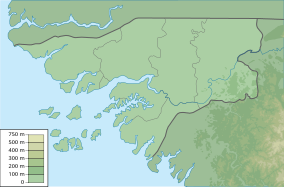Cacheu River Mangroves Natural Park
You can help expand this article with text translated from the corresponding article in French. (November 2013) Click [show] for important translation instructions.
|
| Cacheu River Mangroves Natural Park | |
|---|---|
| Location | Guinea-Bissau |
| Nearest city | Cacheu |
| Coordinates | 12°18′00″N 16°10′46″W / 12.30000°N 16.17944°W |
| Area | 886 km2 (342 sq mi) |
| Established | 2000 |
| Designations | |
|---|---|
| Official name | Parc Naturel des Mangroves du Fleuve Cacheu (PNTC) |
| Designated | 22 May 2015 |
| Reference no. | 2229[1] |
The Cacheu River Mangroves Natural Park (Portuguese: Parque Natural dos Tarrafes do Rio Cacheu) is a national park[2] situated on the Cacheu River in Guinea-Bissau. It was established on 1 December 2000. This site is 886 km2.[3] The park has been designated as a Ramsar site since 2015.[1]
The park is considered to be the largest compact mangrove environment in West Africa, as much as 68% of the territory is covered with mangroves.
Under the protection of mangroves, the reproduction of fishing resources and the preservation of the diversity of flora and fauna are ensured. The park provides a home for many migratory birds in the region.[4]
Climate change
[edit]In 2022, the IPCC Sixth Assessment Report included Cacheu River Mangroves Natural Park in the list of African natural heritage sites which would be threatened by flooding and coastal erosion by the end of the century, but only if climate change followed RCP 8.5, which is the scenario of high and continually increasing greenhouse gas emissions associated with the warming of over 4 °C.,[5] and is no longer considered very likely.[6][7] The other, more plausible scenarios result in lower warming levels and consequently lower sea level rise: yet, sea levels would continue to increase for about 10,000 years under all of them.[8] Even if the warming is limited to 1.5 °C, global sea level rise is still expected to exceed 2–3 m (7–10 ft) after 2000 years (and higher warming levels will see larger increases by then), consequently exceeding 2100 levels of sea level rise under RCP 8.5 (~0.75 m (2 ft) with a range of 0.5–1 m (2–3 ft)) well before the year 4000.[9]
External links
[edit]- APES MAPPER Archived 2010-07-16 at the Wayback Machine
References
[edit]- ^ a b "Parc Naturel des Mangroves du Fleuve Cacheu (PNTC)". Ramsar Sites Information Service. Retrieved 25 April 2018.
- ^ "Guinea Bissau National Park". Bissautourism.com: Guinea Bissau: 88 Heavenly Inhabited Islands. Archived from the original on 7 April 2015. Retrieved 16 November 2015.
- ^ World Database on Protected Areas[permanent dead link]
- ^ "National park of cacheu river mangroves - Réseau Régional d'Aires Marines Protégées en Afrique de l'Ouest". www.rampao.org. Archived from the original on 2021-02-09. Retrieved 2020-09-21.
- ^ Trisos, C.H., I.O. Adelekan, E. Totin, A. Ayanlade, J. Efitre, A. Gemeda, K. Kalaba, C. Lennard, C. Masao, Y. Mgaya, G. Ngaruiya, D. Olago, N.P. Simpson, and S. Zakieldeen 2022: Chapter 9: Africa. In Climate Change 2022: Impacts, Adaptation and Vulnerability [H.-O. Pörtner, D.C. Roberts, M. Tignor, E.S. Poloczanska, K. Mintenbeck, A. Alegría, M. Craig, S. Langsdorf, S. Löschke,V. Möller, A. Okem, B. Rama (eds.)]. Cambridge University Press, Cambridge, United Kingdom and New York, NY, USA, pp. 2043–2121
- ^ Hausfather, Zeke; Peters, Glen (29 January 2020). "Emissions – the 'business as usual' story is misleading". Nature. 577 (7792): 618–20. Bibcode:2020Natur.577..618H. doi:10.1038/d41586-020-00177-3. PMID 31996825.
- ^ Hausfather, Zeke; Peters, Glen (20 October 2020). "RCP8.5 is a problematic scenario for near-term emissions". PNAS. 117 (45): 27791–27792. Bibcode:2020PNAS..11727791H. doi:10.1073/pnas.2017124117. PMC 7668049. PMID 33082220.
- ^ Technical Summary. In: Climate Change 2021: The Physical Science Basis. Contribution of Working Group I to the Sixth Assessment Report of the Intergovernmental Panel on Climate Change (PDF). IPCC. August 2021. p. TS14. Retrieved 12 November 2021.
- ^ IPCC, 2021: Summary for Policymakers. In: Climate Change 2021: The Physical Science Basis. Contribution of Working Group I to the Sixth Assessment Report of the Intergovernmental Panel on Climate Change [Masson-Delmotte, V., P. Zhai, A. Pirani, S.L. Connors, C. Péan, S. Berger, N. Caud, Y. Chen, L. Goldfarb, M.I. Gomis, M. Huang, K. Leitzell, E. Lonnoy, J.B.R. Matthews, T.K. Maycock, T. Waterfield, O. Yelekçi, R. Yu, and B. Zhou (eds.)]. Cambridge University Press, Cambridge, United Kingdom and New York, NY, USA, pp. 3−32, doi:10.1017/9781009157896.001.

